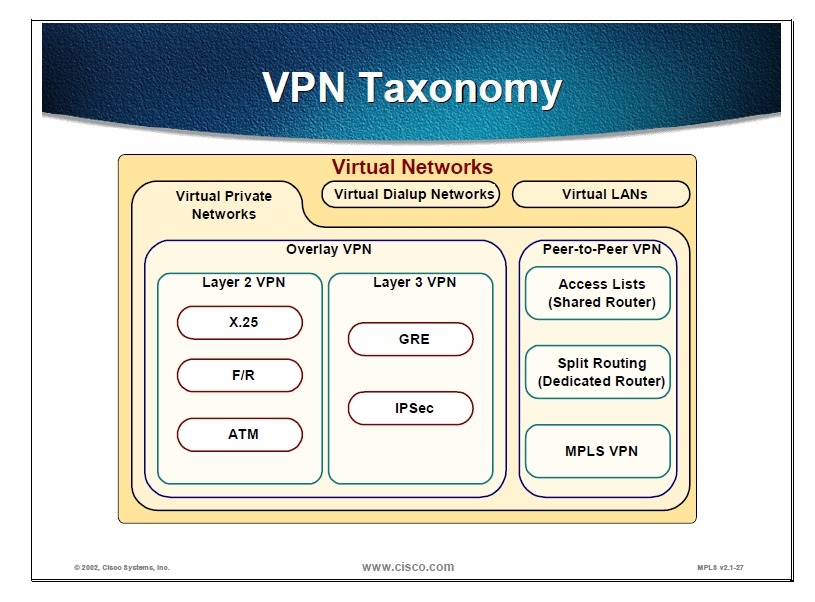

Which type of VPN requires a full mesh of virtual circuits to provide optimal site-to-site connectivity?
Correct Answer:
B
🗳️
 http://etutorials.org/Networking/MPLS+VPN+Architectures/Part+2+MPLS-based+Virtual+Private+Networks/Chapter+7.+Virtual+Private+Network+VPN
http://etutorials.org/Networking/MPLS+VPN+Architectures/Part+2+MPLS-based+Virtual+Private+Networks/Chapter+7.+Virtual+Private+Network+VPN
+Implementation+Options/Overlay+and+Peer-to-peer+VPN+Model/
Two VPN implementation models have gained widespread use:
The overlay model, where the service provider provides emulated leased lines to the customer.
The service provider provides the customer with a set of emulated leased lines. These leased lines are called VCs, which can be either constantly available
(PVCs) or established on demand (SVCs). The QoS guarantees in the overlay VPN model usually are expressed in terms of bandwidth guaranteed on a certain
VC (Committed Information Rate or CIR) and maximum bandwidth available on a certain VC (Peak Information Rate or PIR). The committed bandwidth guarantee usually is provided through the statistical nature of the Layer 2 service but depends on the overbooking strategy of the service provider
The peer-to-peer model, where the service provider and the customer exchange Layer 3 routing information and the provider relays the data between the customer sites on the optimum path between the sites and without the customer's involvement.
The peer-to-peer VPN model was introduced a few years ago to alleviate the drawbacks of the overlay VPN model. In the peer-to-peer model, the Provider Edge
.
(PE) device is a router (PE-router) that directly exchanges routing information with the CPE router
The Managed Network service offered by many service
providers, where the service provider also manages the CPE devices, is not relevant to this discussion because it's only a repackaging of another service. The
Managed Network provider concurrently assumes the role of the VPN service provider (providing the VPN infrastructure) and part of the VPN customer role
(managing the CPE device).
The peer-to-peer model provides a number of advantages over the traditional overlay model:
Routing (from the customer's perspective) becomes exceedingly simple, as the customer router exchanges routing information with only one (or a few) PE-router, whereas in the overlay VPN network, the number of neighbor routers can grow to a large number.
Routing between the customer sites is always optimal, as the provider routers know the customer's network topology and can thus establish optimum inter-site routing.
Bandwidth provisioning is simpler because the customer has to specify only the inbound and outbound bandwidths for each site (Committed Access Rate [CAR] and Committed Delivery Rate [CDR]) and not the exact site-to-site traffic profile.
The addition of a new site is simpler because the service provider provisions only an additional site and changes the configuration on the attached PE-router.
Under the overlay VPN model, the service provider must provision a whole set of VCs leading from that site to other sites of the customer VPN.
Prior to an MPLS-based VPN implementation, two implementation options existed for the peer-to-peer VPN model:
The shared-router approach, where several VPN customers share the same PE-router.
The dedicated-router approach, where each VPN customer has dedicated PE-routers.
Overlay VPN paradigm has a number of drawbacks, most significant of them being the need for the customer to establish point-to-point links or virtual circuits between sites. The formula to calculate how many point-to-point links or virtual circuits you need in the worst case is ((n)(n-1))/2, where n is the number of sites you need to connect. For example, if you need to have fullmesh connectivity between 4 sites, you will need a total of 6 point-to-point links or virtual circuits.
To overcome this drawback and provide the customer with optimum data transport across the Service Provider backbone, the peer-to-peer VPN concept was introduced where the Service Provider actively participates in the customer routing, accepting customer routes, transporting them across the Service Provider backbone and finally propagating them to other customer sites.
Which three Layer 3 VPN technologies are based on the overlay model? (Choose three.)
Correct Answer:
CDF
🗳️
Which VPN technology uses the Group Domain of Interpretation as the keying protocol and IPsec for encryption that is often deployed over a private MPLS core network?
Correct Answer:
B
🗳️
What is the primary difference between 6PE and 6VPE?
Correct Answer:
C
🗳️